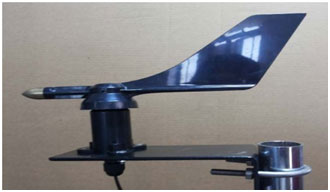Wind Direction Sensor

What is a Wind Direction Sensor?
A Wind Direction Sensor is also known as a wind vane sensor. It’s a precision instrument that’s designed to measure the direction from which the wind is exactly blowing. This sensor generally uses a rotating vane connected to a potentiometer, or sometimes an encoder that converts wind movement into electrical signals. These signals are then processed and displayed through a wind monitoring system.
Such sensors actually play a crucial role in meteorological equipment, solar tracking systems, and industrial automation, where accurate wind data is really important for safety, performance and energy optimization. By integrating a reliable wind direction sensor, organizations can improve forecasting accuracy, enhance system efficiency, and ensure stable operation in weather-dependent applications like wind farms, airports, and research stations.
How Does a Wind Direction Sensor Work?
A wind direction sensor works on a simple yet effective working principle that actually converts the movement of air into readable data. Here’s how exactly it functions:
Wind Direction Sensor Technical Specifications
| Sensor Type : | Wind vane potentiometer Type | Material : | Control Head UV-resistant ABS |
| Wind Vane : | Polycarbonate | Range : | 0–360° |
| Accuracy : | ± 3 | Output : | 0 – 5v |
| Supply : | 12 to 24 vdc | Cable length : | 2 mts |
| Temperature : | - 40 ~ 75 ° C | Colour Code : | Brown :Supply ,Black : Gnd, Blue : output |
Key Benefits of the Logics PowerAMR Wind Direction Sensor
Applications & Use Cases of Wind Direction Sensors
The PowerAMR wind direction sensor delivers precise wind data for a variety of critical applications:
| Weather and Meteorological Stations: Provides accurate wind direction for forecasting and climate analysis. | |
| Solar and Hybrid Energy Projects: Optimizes panel orientation and system performance based on wind conditions. | |
| Wind Turbine Control: Enhances turbine efficiency by adjusting to real-time wind direction. | |
| Agriculture and Irrigation Systems: Supports efficient irrigation and pesticide application by monitoring wind patterns. | |
| Environmental Research & Air Quality: Tracks pollutant dispersion and wind behavior for studies and monitoring. | |
| Smart Cities & Industrial Automation: Integrates wind data for building management, ventilation, and machinery safety. |
Integration & Compatibility
Our wind direction sensor is truly especially designed for seamless integration with a wide range of monitoring control systems. Its 0-5 analog output allows easy connection to Logics PowerAMR’s remote monitoring system, third-party controllers, or even data loggers for real-time IoT platforms, and enables centralized monitoring of environmental and renewable energy parameters.
This compatibility ensures that wind direction can be efficiently recorded, analyzed, and utilized for automation, performance automation, along with safety applications, and this makes it a versatile choice for meteorological, industrial, and solar energy projects.
Mounting
| Allow sufficient clearance for the wind sensor. Install the wind sensor away from buildings or any other objects that might affect the airflow | |
| Try to make the sensors the highest object around. 7 feet or more above the surrounding obstructions is best | |
| The sensor must be mounted in an upright position; otherwise, water can enter the sensor and destroy it |

